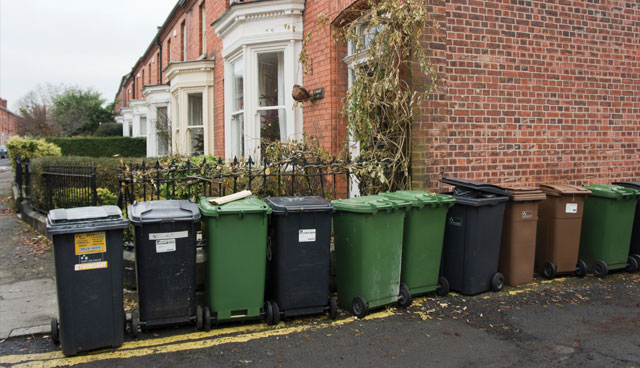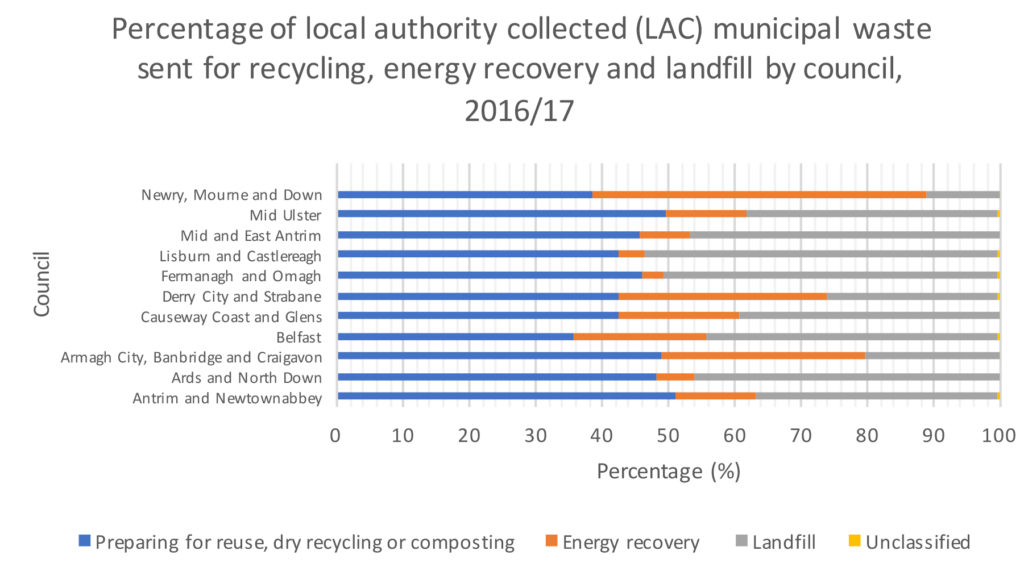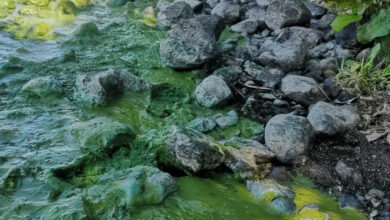Waste management

The Department of Agriculture, Environment and Rural Affairs (DAERA) has published its annual report on Northern Ireland Local Authority Collected Municipal Waste (LACMW) Statistics for 2016/17.
LAC municipal waste data incorporates all waste under the control of local government councils. The annual report published by DAERA contains final validated information which is then used to analyse performance in relation to LACMW targets.
The 11 councils collected 985,994 tonnes of LACMW in 2016/17, a 1.7 per cent increase on the 969,157 collected the previous year. Currently, 59 per cent of the population across six councils (Mid and East Antrim, Antrim and Newtownabbey, Belfast, Ards and North Down, Lisburn and Castlereagh and Newry, Mourne and Down) is affiliated with the arc21 waste management group (WMG), two councils (Causeway Coast and Glens and Derry City and Strabane) and 16 per cent of the population with the North West Regional Waste Management Group and the remaining 25 per cent of the population across three councils (Armagh City, Banbridge and Craigavon, Mid Ulster and Fermanagh and Omagh) are unaligned to a WMG.
With a distinction between LACMW arisings and household waste arising, there are three key performance indicators (KPI) used to monitor performance:
- total LAC municipal waste arisings, KPI (j);
- household waste arisings per capita, KPI (p); and
- household waste arisings per household, KPI (h).
Of the total, 88.8 per cent was household waste (which includes materials collected directly from households and material taken to civic amenity sites). 44.4 per cent of household waste was sent to reuse preparation, dry recycling and composting (2.2 per cent higher than 2015/16), ranging between 39.4 per cent in Belfast to 51.6 per cent in Mid Ulster. Performance, however, again fails to meet the stated target of achieving a recycling rate of 45 per cent for household waste by 2015. Likewise, it remains to be seen whether a targeted 50 per cent recycling rate for 2020 is achievable.
LACMW energy recovery was 18.5 per cent, slightly up (0.9 per cent) on the previous year, the highest rate being in Newry, Mourne and Down (50.4 per cent) and the lowest in Fermanagh and Omagh (3.1 per cent).
The rate of household waste that is landfilled has dropped 3 per cent from 2015/16 to a record low of 36.7 per cent, a reduction from 72.3 per cent in 2006/07. As such, targets of landfilling no more than 262,857 tonnes of biodegradable LACMW by the end of March 2017 and 220,000 tonnes by the end of March 2020 were met in 2016/17 (204,380 tonnes).
The proportion of LACMW collected broadly mirrors council population. For instance, in 2016/17, Belfast had the greatest waste arisings representing 17 per cent of the total waste arising in area which incorporates 18 per cent of the total population. Reflecting the concentration of business, Belfast also had the greatest proportion of non-household LACMW arisings (25 per cent). At the opposite end of the spectrum, Fermanagh and Omagh had the lowest waste arisings representing 5 per cent of the total waste arising in a local government area home to 6 per cent of the population.
Antrim and Newtownabbey and Mid Ulster had the most significant increases in their LACMW arisings of 7.7 per cent and 6.6 per cent respectively. On the other hand, waste arising decreased by 2.1 per cent in Newry, Mourne and Down and 4.8 per cent in North Down and Ards.
In 2016/17, there were 470kg of household waste collected per capita (up by 5kg) and 1.190 tonnes per household (up by 0.011 tonnes). Belfast City Council generated the least household waste per person at average of 427kg, while Antrim and Newtownabbey produced the greatest with an average of 555kg.
In terms of household, Belfast produced the least household waste per household (0.989 tonnes) compared with Mid Ulster where the 1.461 tonnes were produced per household. While Mid Ulster has the largest average household size of the 11 councils, this represents a 3.9 per cent increase on the previous annual report.








